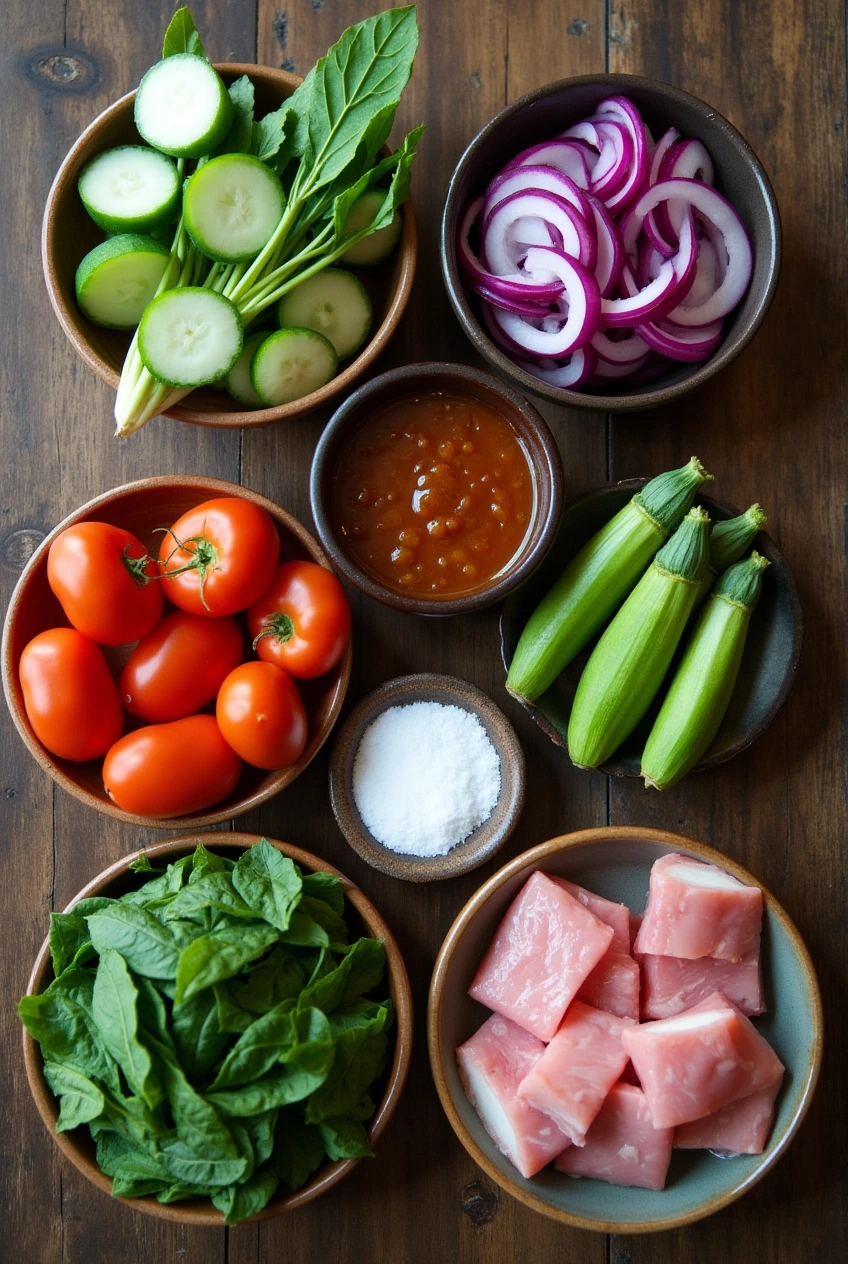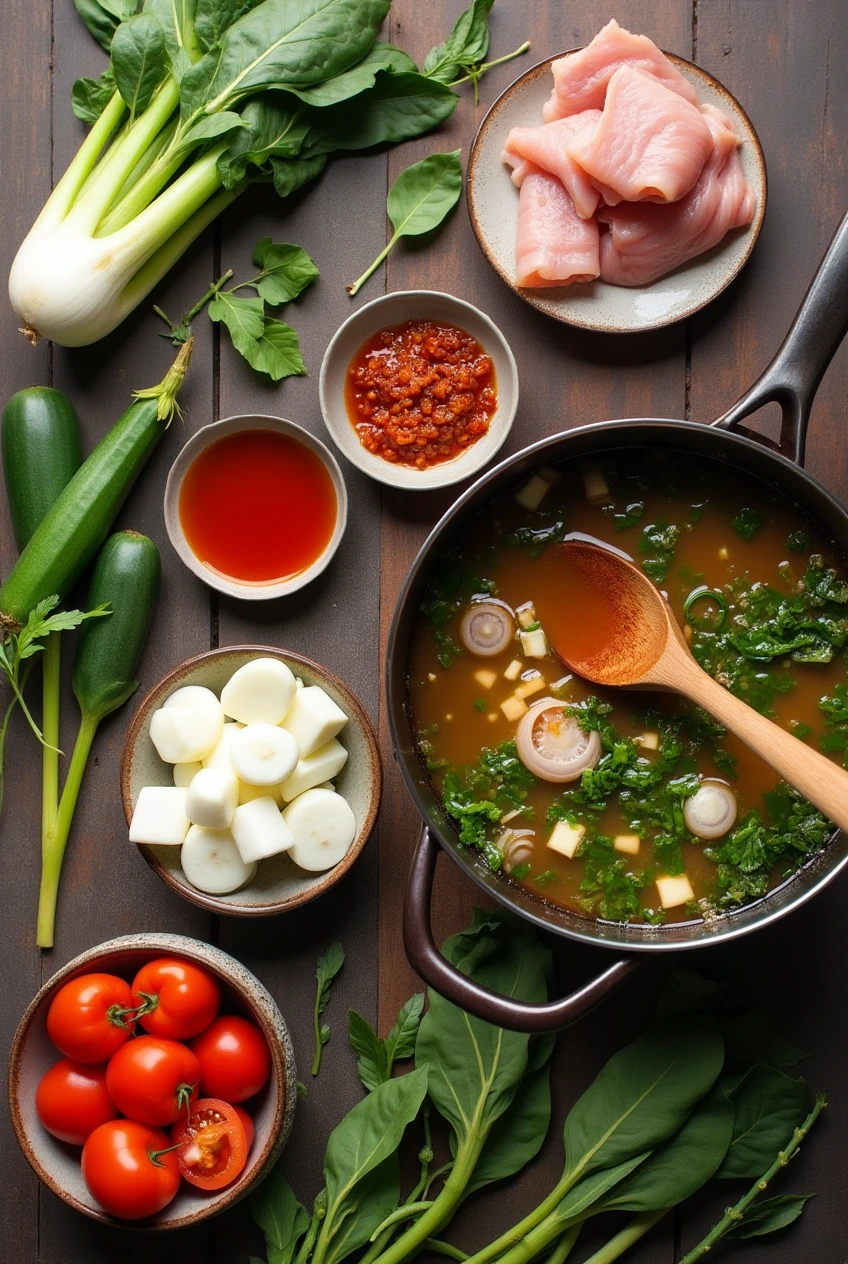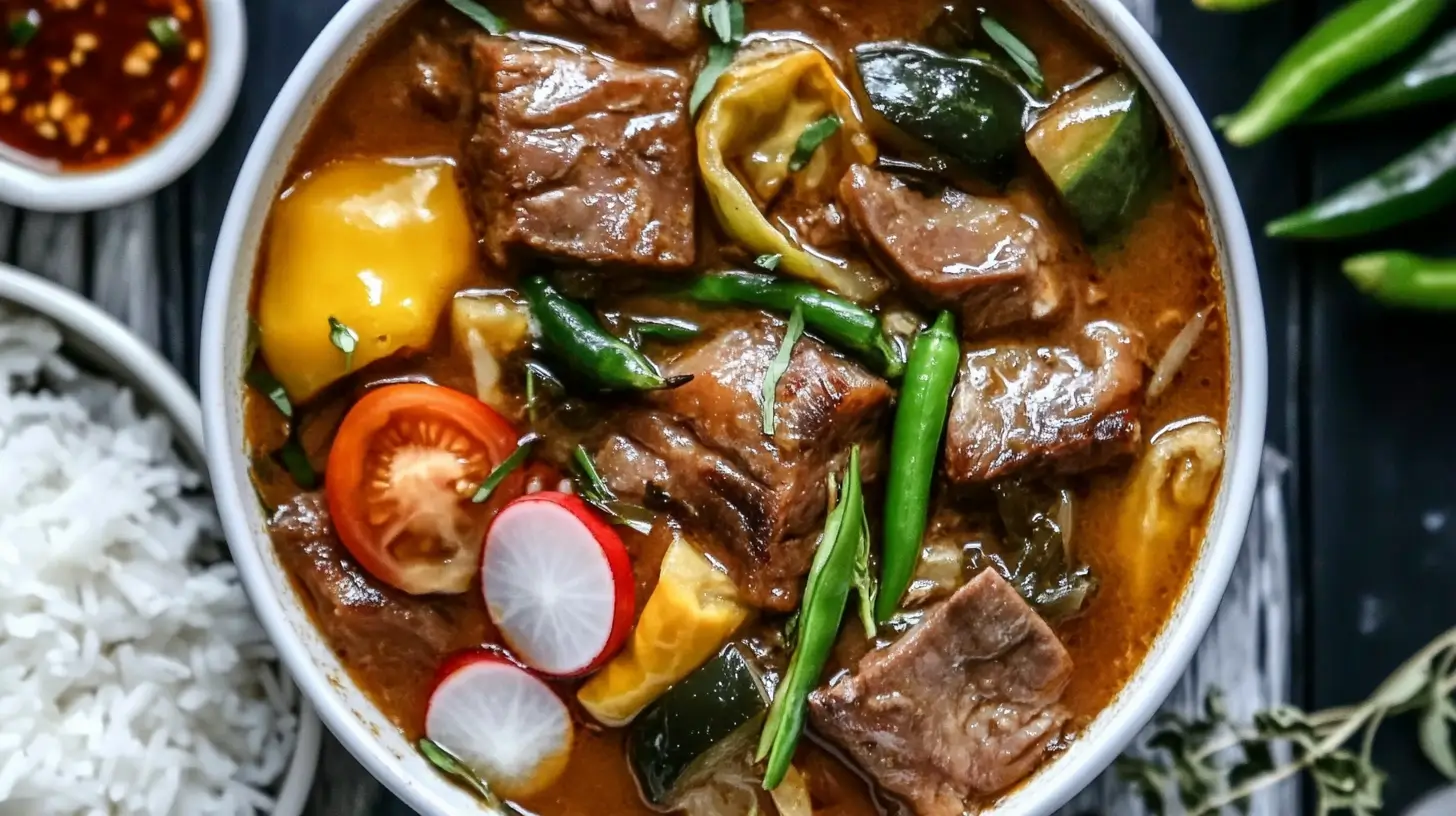There’s something magical about a bowl of sinigang, isn’t there? This classic Filipino comfort food has a way of wrapping you in warmth with its perfect balance of sour and savory flavors. Whether it’s a rainy day or you’re simply craving something hearty, sinigang is the ultimate soul-warming dish that’s as versatile as it is delicious.
Packed with nutritious vegetables, tender protein, and the tangy goodness of tamarind, this dish is a favorite at family gatherings and weeknight dinners alike. Plus, it’s incredibly adaptable—you can swap ingredients to suit your taste or what’s available in your pantry.
Ready to bring a taste of the Philippines to your table? Let’s dive into this timeless recipe that’s guaranteed to delight your taste buds and warm your heart!
Table of contents
Key Benefits of Sinigang
Why do so many people fall in love with sinigang? It’s more than just a dish; it’s a heartwarming experience. Here’s what makes this classic Filipino soup a standout on any table:
- Nutritious and Balanced: Packed with a medley of fresh vegetables like radish, water spinach, and eggplant, sinigang is a wholesome meal that’s as good for your body as it is for your soul. The tamarind base is a natural source of vitamin C, supporting immunity while adding a delightful tang.
- Versatile and Adaptable: Whether you prefer pork, shrimp, beef, or even tofu, sinigang adapts beautifully to your protein preferences. This flexibility makes it perfect for vegetarians, pescatarians, or anyone experimenting with new flavors.
- Perfect Comfort Food: Its rich, savory broth and signature sourness are like a warm hug in a bowl, especially on rainy days or when you’re feeling under the weather. It’s a dish that’s sure to bring everyone around the table together.
- Easy to Make: Despite its complex flavor profile, sinigang is surprisingly straightforward to prepare. With the right steps, you can have a steaming pot of this Filipino favorite ready in under an hour.
- Cultural Connection: Cooking sinigang is like embracing a piece of the Philippines on your plate. It’s a dish steeped in tradition, bringing a taste of home to every bite.
Ready to create this soul-warming, nutritious dish? Let’s explore the ingredients you’ll need!
Ingredients for Sinigang

To bring this comforting Filipino classic to life, you’ll need a mix of fresh vegetables, your preferred protein, and a handful of pantry staples. Here’s everything you’ll need:
For the Broth:
- Tamarind base: 1 packet of tamarind mix or ½ cup of fresh tamarind pulp (for that signature sour kick).
- Water: 6 cups, to create the rich, flavorful soup base.
- Fish sauce: 2 tablespoons, for a touch of umami.
- Salt and pepper: To taste.
Protein Options:
- Pork belly or ribs: 1 pound, cut into bite-sized pieces for tender, flavorful bites.
- Shrimp: 1 pound, peeled and deveined (if you prefer a lighter option).
- Tofu: 1 block, cubed (a great alternative for vegetarians).
Fresh Vegetables:
- Radish (labanos): 1 medium, sliced thin for a mild, crunchy texture.
- Water spinach (kangkong): 1 bunch, washed and trimmed.
- Eggplant: 2 small, cut into wedges for a tender, earthy flavor.
- Tomatoes: 2 medium, quartered to add a subtle sweetness.
- Okra: 6 pieces, trimmed (optional, for a slightly sticky texture).
- Onion: 1 medium, sliced, to enhance the broth’s depth.
Optional Add-Ons:
- Green chili: 1-2 pieces, whole, for a gentle heat without overwhelming the dish.
- Calamansi or lemon juice: A splash, for an extra citrusy brightness.
Pro Tips for Choosing Ingredients:
- For the most authentic flavor, fresh tamarind is worth the effort if available. Simply boil, mash, and strain it to create your sour base.
- Swap proteins to suit your mood—pork adds richness, while shrimp keeps the dish light and refreshing.
- Use in-season vegetables for optimal freshness and taste.
Gather these simple yet flavorful ingredients, and you’re just a few steps away from making a bowl of heartwarming sinigang! Up next: Let’s cook!
Instructions: How to Make Sinigang

Creating sinigang is a joyful and straightforward process. Follow these easy steps to bring this hearty Filipino dish to life:
1. Prepare Your Ingredients
- Wash and chop all the vegetables as described in the ingredients section. Keep them separated, as they’ll be added to the pot at different times.
- If you’re using fresh tamarind, boil it with 2 cups of water until soft, mash it to extract the pulp, and strain to separate the seeds.
2. Sauté for Flavor
- Heat a large pot over medium heat and add a drizzle of cooking oil.
- Sauté the sliced onion and quartered tomatoes until soft and fragrant, about 3-4 minutes.
3. Build the Broth
- Add your choice of protein (pork or shrimp) to the pot and lightly sauté for 5-7 minutes (if using tofu, add later to prevent overcooking).
- Pour in 6 cups of water and bring it to a boil. Skim off any foam or impurities that rise to the surface for a clearer broth.
- Stir in the tamarind base or fresh tamarind pulp, then season with fish sauce, salt, and pepper. Let it simmer gently for 10-15 minutes to allow the flavors to meld.
4. Add the Vegetables
- Begin with the harder vegetables like radish and eggplant. Let them cook for 5 minutes until they start to soften.
- Add the okra (if using) and cook for another 3 minutes.
- Finally, add the water spinach and whole green chilies. Simmer for 1-2 minutes until the greens are wilted but vibrant.
5. Taste and Adjust
- Taste your broth and adjust the seasoning if needed. If it’s too sour, balance it with a pinch of sugar. If you want more tang, add a splash of calamansi or lemon juice.
6. Serve and Enjoy
- Serve your steaming hot sinigang with a side of freshly steamed rice. Make sure to ladle plenty of broth into each bowl for that comforting, flavorful experience!
Pro Cooking Tips:
- For shrimp sinigang, add the shrimp in the final 5 minutes of cooking to avoid overcooking.
- If reheating leftovers, add a splash of water to the broth to retain its original consistency.
With these easy steps, you’ve mastered the art of cooking sinigang. Up next, learn how to customize it and make it your own!
Pro Tips and Variations for Sinigang
One of the best things about sinigang is its versatility. You can tailor this classic dish to suit your preferences, dietary needs, or even the ingredients you have on hand. Here are some expert tips and creative variations to make your sinigang truly unique:
Pro Tips for the Perfect Sinigang
- Enhance the Broth: For a richer flavor, simmer pork or beef bones along with your protein. The natural collagen will add depth and body to the broth.
- Balance the Sourness: If the tamarind base feels too strong, mellow it out with a small pinch of sugar or a splash of coconut milk for a creamy twist.
- Cook Vegetables Just Right: Add vegetables in stages based on their cooking time to ensure they stay tender and vibrant without becoming mushy.
- Layer the Seasoning: Season gradually and taste as you go. This helps you achieve a perfectly balanced broth that’s neither too salty nor too bland.
Variations to Try
- Seafood Sinigang
- Swap pork with shrimp, mussels, or milkfish (bangus) for a lighter, ocean-inspired version. Add seafood towards the end of cooking to avoid overcooking.
- Vegetarian Sinigang
- Skip the meat and double up on vegetables. Add tofu cubes for protein, and use vegetable stock instead of water for a fuller flavor.
- Beef Sinigang
- Use tender cuts like beef shank or short ribs for a heartier version. Simmer the beef longer to ensure it’s fall-off-the-bone tender.
- Spicy Sinigang
- For those who love heat, slice green chilies and add them directly to the broth. Alternatively, serve with a side of chili oil for customizable spice levels.
- Regional Twists
- Experiment with adding other souring agents like calamansi, green mango, or even tamarind-flavored soup base cubes, depending on what’s locally available.
Make It Your Own
Sinigang is a dish that welcomes creativity. Feel free to mix and match proteins and vegetables, or add your favorite spices to put your personal stamp on it. Whether you stick to tradition or put a modern spin on this Filipino classic, the result will always be delicious.
Let’s move on to how you can serve this comforting dish for the ultimate dining experience!
Serving Suggestions for Sinigang
Sinigang is best enjoyed as a communal dish, bringing friends and family together around a warm, flavorful meal. Here’s how to serve it for the most satisfying experience:
1. Pair It with Steamed Rice
- Sinigang’s savory, tangy broth is perfect for pouring over a bowl of fluffy white rice. The rice soaks up the delicious flavors, creating a hearty and balanced meal.
- For a twist, try it with garlic fried rice to add a hint of richness to your meal.
2. Serve with Dipping Sauces
- Elevate the flavors with a side of dipping sauce. Combine fish sauce, calamansi, and a dash of chili for a zesty, spicy kick that complements the dish perfectly.
- Soy sauce with chopped red chilies and garlic is another great option for those who prefer a saltier profile.
3. Add Side Dishes for Variety
- Pair your sinigang with crispy sides like lumpiang shanghai (Filipino spring rolls) or fried fish for a delightful contrast in texture.
- For a lighter side, serve a simple ensaladang talong (eggplant salad) to complement the soup’s tangy flavors.
4. Serve Family-Style
- Place the pot of steaming sinigang in the center of the table, along with a big serving spoon. Let everyone ladle out their desired portion, making the meal feel more interactive and fun.
5. Beverage Pairings
- A cold glass of calamansi juice or iced tea balances the warm, sour notes of the dish beautifully.
- For adults, a light beer or dry white wine pairs well with the savory and tangy flavors.
Tips for Presentation
- Serve sinigang in a large bowl with the vibrant vegetables on top to highlight their fresh colors.
- Add a garnish of freshly chopped green onions or whole chilies for an extra pop of color and flavor.
Whether served as a cozy weeknight dinner or the star of a family gathering, sinigang is sure to impress and satisfy. Up next: Let’s wrap up with some final thoughts and FAQs!
Conclusion: Why You’ll Love This Sinigang Recipe
Crafting sinigang is more than just preparing a meal—it’s creating a comforting experience that brings warmth to your heart and joy to your table. This dish, with its signature tangy tamarind base, fresh vegetables, and tender protein, is a celebration of Filipino cuisine and culture.
What makes this recipe truly special is its versatility and simplicity. It’s perfect for weeknight dinners, when you crave something hearty yet easy to make, or as a showstopping dish for family gatherings. With just a few fresh ingredients and some pantry staples, you can whip up a bowl of sinigang that’s brimming with flavor and nutrition.
Remember, sinigang is more than just a recipe—it’s a chance to get creative in the kitchen. Whether you prefer it classic, spicy, or with a modern twist, this dish is sure to delight your taste buds and bring everyone closer together around the table.
So why not give this recipe a try? Your next bowl of warm, hearty sinigang is just a few steps away!
Up next: Get answers to your most common questions about preparing and serving sinigang in our FAQ section.
Print
Sinigang Recipe That Will Warm Your Heart Instantly
- Total Time: 1 hour
- Yield: 6 servings
Description
Discover the ultimate sinigang recipe with a tangy tamarind broth, fresh veggies, and tender protein. Perfect for comfort food lovers!
Ingredients
For the Broth:
- Tamarind base: 1 packet of tamarind mix or ½ cup of fresh tamarind pulp (for that signature sour kick).
- Water: 6 cups, to create the rich, flavorful soup base.
- Fish sauce: 2 tablespoons, for a touch of umami.
- Salt and pepper: To taste.
- Protein Options:
- Pork belly or ribs: 1 pound, cut into bite-sized pieces for tender, flavorful bites.
- Shrimp: 1 pound, peeled and deveined (if you prefer a lighter option).
- Tofu: 1 block, cubed (a great alternative for vegetarians).
Fresh Vegetables:
- Radish (labanos): 1 medium, sliced thin for a mild, crunchy texture.
- Water spinach (kangkong): 1 bunch, washed and trimmed.
- Eggplant: 2 small, cut into wedges for a tender, earthy flavor.
- Tomatoes: 2 medium, quartered to add a subtle sweetness.
- Okra: 6 pieces, trimmed (optional, for a slightly sticky texture).
- Onion: 1 medium, sliced, to enhance the broth’s depth.
Optional Add-Ons:
- Green chili: 1-2 pieces, whole, for a gentle heat without overwhelming the dish.
- Calamansi or lemon juice: A splash, for an extra citrusy brightness.
Pro Tips for Choosing Ingredients
- For the most authentic flavor, fresh tamarind is worth the effort if available. Simply boil, mash, and strain it to create your sour base.
- Swap proteins to suit your mood—pork adds richness, while shrimp keeps the dish light and refreshing.
- Use in-season vegetables for optimal freshness and taste.
Instructions
1. Prepare Your Ingredients
- Wash and chop all the vegetables as described in the ingredients section. Keep them separated, as they’ll be added to the pot at different times.
- If you’re using fresh tamarind, boil it with 2 cups of water until soft, mash it to extract the pulp, and strain to separate the seeds.
2. Sauté for Flavor
- Heat a large pot over medium heat and add a drizzle of cooking oil.
- Sauté the sliced onion and quartered tomatoes until soft and fragrant, about 3-4 minutes.
3. Build the Broth
- Add your choice of protein (pork or shrimp) to the pot and lightly sauté for 5-7 minutes (if using tofu, add later to prevent overcooking).
- Pour in 6 cups of water and bring it to a boil. Skim off any foam or impurities that rise to the surface for a clearer broth.
- Stir in the tamarind base or fresh tamarind pulp, then season with fish sauce, salt, and pepper. Let it simmer gently for 10-15 minutes to allow the flavors to meld.
4. Add the Vegetables
- Begin with the harder vegetables like radish and eggplant. Let them cook for 5 minutes until they start to soften.
- Add the okra (if using) and cook for another 3 minutes.
- Finally, add the water spinach and whole green chilies. Simmer for 1-2 minutes until the greens are wilted but vibrant.
5. Taste and Adjust
- Taste your broth and adjust the seasoning if needed. If it’s too sour, balance it with a pinch of sugar. If you want more tang, add a splash of calamansi or lemon juice.
6. Serve and Enjoy
- Serve your steaming hot sinigang with a side of freshly steamed rice. Make sure to ladle plenty of broth into each bowl for that comforting, flavorful experience!
Pro Cooking Tips:
- For shrimp sinigang, add the shrimp in the final 5 minutes of cooking to avoid overcooking.
- If reheating leftovers, add a splash of water to the broth to retain its original consistency.
Notes
- To balance the tanginess of the tamarind broth, add a pinch of sugar if desired.
- If using seafood like shrimp, add it in the final 5 minutes of cooking to prevent overcooking.
- Store leftovers in an airtight container in the refrigerator for up to 3 days or freeze for up to 3 months.
- Experiment with different vegetables, such as string beans or bok choy, for a personalized twist.
This recipe recap is designed to provide a clear, professional overview for any home cook or food enthusiast while ensuring all details are visually appealing and easy to follow.
- Prep Time: 15 minutes
- Cook Time: 45 minutes
- Category: Soup, Main Dish
- Method: Simmering
- Cuisine: Filipino
Nutrition
- Serving Size: 6
- Calories: 250 kcal per serving
- Sugar: 5g
- Sodium: 800mg
- Fat: 10g
- Saturated Fat: 3g
- Unsaturated Fat: 6g
- Trans Fat: 0g
- Carbohydrates: 15g
- Fiber: 4g
- Protein: 20g
- Cholesterol: 40mg
FAQs: Your Sinigang Questions Answered
Making sinigang for the first time or looking to perfect your recipe? Here are answers to some of the most commonly asked questions to help you along the way:
1. Can I make sinigang without tamarind?
Absolutely! While tamarind is the traditional souring agent, you can substitute it with calamansi juice, green mangoes, or even lemon juice. These alternatives provide a unique tangy flavor while keeping the essence of sinigang intact.
2. How can I store leftovers?
Store any leftover sinigang in an airtight container and refrigerate for up to 3 days. When reheating, add a splash of water to the broth to restore its original consistency.
3. Can I freeze sinigang?
Yes, sinigang freezes well! Place it in a freezer-safe container and store it for up to 3 months. Thaw in the refrigerator overnight and reheat gently on the stovetop to retain its flavor and texture.
4. What protein works best for sinigang?
The beauty of sinigang lies in its versatility. Pork belly is the most popular choice for its richness, but shrimp, beef shank, milkfish (bangus), or tofu all work wonderfully depending on your taste and dietary needs.
5. How can I make the broth less sour?
If your broth turns out too tangy, balance it with a pinch of sugar or add more water. Taste as you go to achieve your desired level of sourness.
6. Can I make sinigang vegetarian or vegan?
Absolutely! Swap out the meat for tofu, and use vegetable stock instead of water for the base. Load up on your favorite vegetables to make a hearty and nutritious vegan sinigang.
7. What are the best vegetables to use?
Traditional sinigang includes vegetables like radish, water spinach (kangkong), eggplant, and okra, but feel free to experiment with other options like string beans, bok choy, or even bell peppers for a twist.
Have More Questions?
If you’re still wondering about anything, feel free to leave a comment below. I’d love to help you perfect your sinigang-making journey!
Happy cooking and enjoy your bowl of comforting, tangy sinigang!


4 thoughts on “Sinigang Recipe That Will Warm Your Heart Instantly”